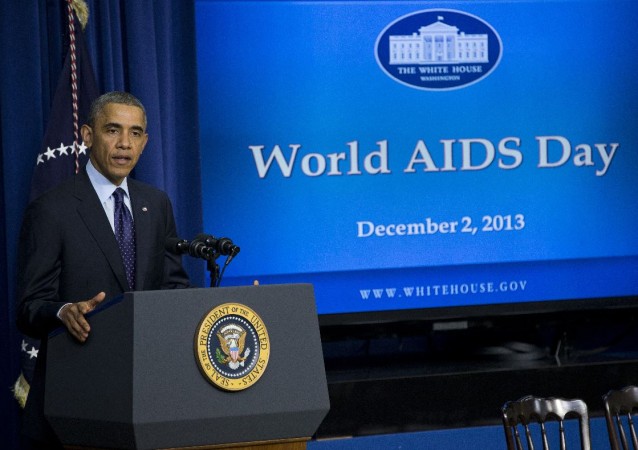Why Beating AIDS May Require Less International Aid – ThinkProgress
by Sam P.K. Collins Posted on
Posted on
 CREDIT: AP Photo/ Evan Vucci
CREDIT: AP Photo/ Evan Vucci
Since its 2003 inception, the President’s Emergency Plan For AIDS Relief (PEPFAR) has given nearly $63 billion as part of an effort to mitigate the spread of HIV/AIDS and save the lives of those in the Motherland affected by the global epidemic.
Those finances have provided antiretroviral treatment for more than 7 million people, funded HIV testing and counselling for more than 14 million pregnant women, and supported more than 6 million voluntary medical male circumcision procedures.
However, as PEPFAR’s coffers tighten amid a growing demand for antiretroviral medication, the debate rages on about the greater role that Africa’s more financially solvent nations can play in eradicating HIV/AIDS.
“This is going to cost more money over the next few years, but the question of where the funding will come from is complicated,” Dr. Robert Hecht, an author of a Harvard School of Public Health and the Results for Development Institute study that explores this issue, told Voice of America. In the study, researchers test the capacity of more than one dozen African countries with a high prevalence of HIV/AIDS — including Botswana, Namibia, South Africa, and Ethiopia — to increase domestic HIV/AIDS spending.
“We know that treatment has a preventive effect; it slows down the rate of transmission of HIV. We have more tools on the prevention side like medical male circumcision. All of these things cost quite a bit of money, so the balance between the national — the domestic funding — and the outside funding needs to be re-thought, re-calibrated. And our study feeds right into that discussion and debate,” Hecht said.
While developed countries have made progress in helping the Motherland combat HIV/AIDS, their assistance hasn’t been sufficient in keeping up with the increase in cases on the continent. Analysts estimate the resource gap for HIV/AIDS funding to reach $22 million this year, due in part to the United States’ declining commitment to funding these efforts.
There’s still hope in the ongoing fight, however, because of the growing capacity of some African countries to tackle the virus on their own. Annual HIV/AIDS spending recently reached $1 billion in South Africa. Domestic spending in response to HIV/AIDS among Sub-Saharan African countries topped $9 billion in 2012, especially as Kenya, Togo, and Zambia increased domestic spending within the last seven years.
The Harvard University study, published in the January issue of the Lancet Global Health, found that if PEPFAR’s 12 partner countries met proposed spending benchmarks, domestic HIV/AIDS spending would cover 64 percent of estimated future spending — ultimately reallocating funding from PEPFAR and the Global Fund to meet other needs.
The increase in shared responsibility could benefit the Motherland in ways that go well beyond the global HIV/AIDS epidemic. Africans have long wanted to shift away from a dependence on international aid, especially as the growth of some of the countries’ economies outpace that of the continent. In 2005, a group of analysts criticized the effectiveness of perpetual Western aid in the decades after African countries found their independence from European countries.
“Helping Africa is a noble cause, but the campaign has become a theater of the absurd — the blind leading the clueless,” Thompson Ayodele, Franklin Cudjoe, Temba A. Nolutshungu, and Charles K. Sunwabe wrote in an article published by the Cato Institute. “The record of Western aid to Africa is one of abysmal failure. More than $500 billion in foreign aid — the equivalent of four Marshall Aid Plans — was pumped into Africa between 1960 and 1997. Instead of increasing development, aid has created dependence. The budgets of Ghana and Uganda, for example, are more than 50 percent aid dependent.”
Absolving from Western aid, while a courageous goal, may not happen anytime soon. Poverty, hunger, and income inequality eclipsing the United States’ and other First World countries remains a major hurdle for many African countries. Even the Harvard researchers admitted that the “low-income” countries in their assessment — including Mozambique and Ethiopia — don’t quite have what it takes to be more self-sufficient in the fight against HIV/AIDS.
But that hasn’t stopped some nations from attempting to do so while strengthening infrastructure and maintaining autonomy over domestic policy. Dependence on aid in low-income countries has fallen by one-third since 2000, according to United Kingdom-based organization ActionAid. That change has come amid an increasing realization that taking foreign money takes power away from the people in holding their government accountable in matters of education and health.
The wave of self-determination in Africa has influenced actions of political leaders in recent years. In 2013, Berhanu Kebede, the Ethiopian ambassador to the United Kingdom, outlined the East African country’s plans to make long-term investments in higher education, agriculture, and manufacturing that would ultimately improve its standing in the global economy.
“Aid plays a significant role but, generally, it’s a declining trend. I’m not trying to undermine the role of aid, but our main aim is to move from aid to trade and investment. Our target is to become a middle income country by 2020 and, by 2030, to be [classification] as developed,” Kedebe told BBC.Since its 2003 inception, the President’s Emergency Plan For AIDS Relief (PEPFAR) has given nearly $63 billion to 15 African countries as part of an effort to mitigate the spread of HIV/AIDS and save the lives of those in the Motherland affected by the global epidemic.




